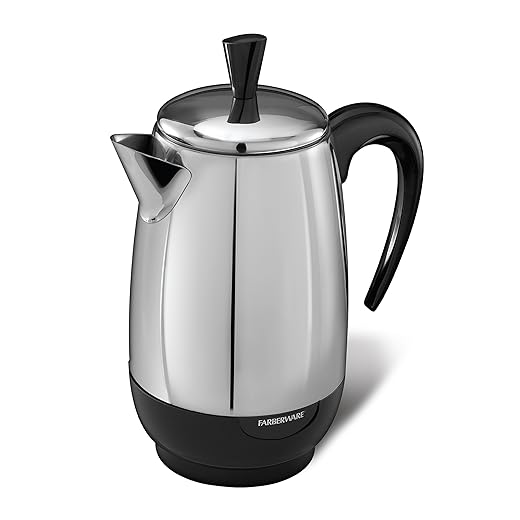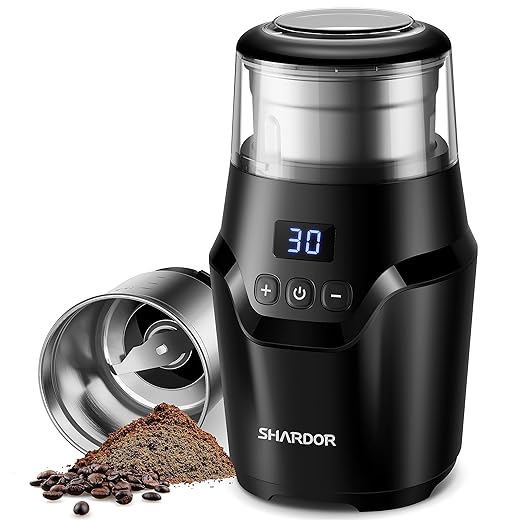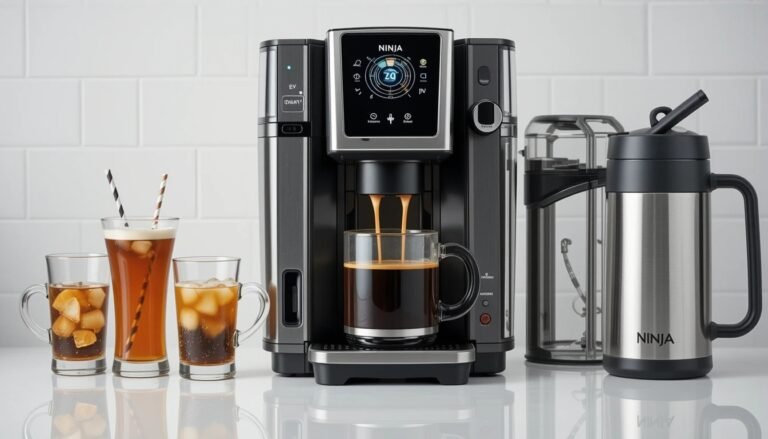Welcome to the World of Coffee Percolation
Have you ever wondered about the art of brewing coffee? Coffee percolation is more than just a method; it’s a celebration of flavor and an invitation to discover the magical journey of aromas and tastes.
In the vast landscape of coffee brewing techniques, percolation stands out for its rich history and unique approach. This method allows water to dance through coffee grounds, drawing out the essence of each bean. It’s a ritual that many enthusiasts cherish, creating a warm connection with their morning routine.
As readers delve deeper into this article, they will uncover the fundamentals of coffee percolation. From understanding the various types of percolators available to mastering the nuances of flavor, the world of coffee percolation promises a delightful adventure. So, grab your favorite mug and prepare to unleash the full potential of every cup!
Amazon.com
Understanding the Basics of Coffee Percolation
Coffee percolation is a fascinating brewing method that combines science with sensory delight. At its core, percolation involves cycling hot water through coffee grounds to extract rich flavors and create a satisfying brew. The process might seem simple, but it relies on several key principles that every coffee aficionado should know.
The Percolation Process
In a percolator, water is heated in a base chamber, generating steam and pressure. This steam forces water up a central tube and into a coffee basket filled with grounds. As hot water saturates the grounds, it absorbs oils and flavor compounds, before flowing back down to the bottom chamber. This cycle can repeat multiple times, intensifying the flavor profile as the brewed coffee continues to steep.
One of the most intriguing aspects of percolation is its ability to highlight the unique characteristics of coffee beans. Different origins, roast levels, and grind sizes can all influence taste. For example, a coarser grind may yield a milder flavor, while a finer grind provides a bolder, richer cup.
The Science of Extraction
Understanding extraction—the process of dissolving soluble compounds from coffee grounds—is crucial. The water temperature, brewing time, and coffee-to-water ratio all play pivotal roles. For optimal extraction, it’s essential to strike the right balance. Too short a brewing time or too low a temperature might produce under-extracted coffee—sour and weak. Conversely, over-extraction can lead to bitterness and unpleasant flavors.
To achieve that perfectly balanced cup, experts recommend experimenting with various parameters. For instance, using a kitchen scale to measure coffee and water can streamline the brewing process, ensuring consistency every time.
Embarking on this journey of flavor exploration requires the right tools. A good coffee grinder is essential for producing uniform grounds, which is key to achieving a balanced extraction. Fresh, evenly-ground coffee will elevate the overall quality of the percolated brew.
As readers begin to grasp these essentials of percolation, the next step is to choose the right type of percolator, which can further enhance their brewing experience. Understanding the tools of the trade will lead to perfected coffee exploration and increase the joy that comes with every cup.
Types of Coffee Percolators: A Guide to Choosing the Right One
When it comes to percolating coffee, having the right equipment can make all the difference. There are various types of coffee percolators available, each with unique features and benefits. Understanding these options is crucial for anyone looking to elevate their coffee brewing game.
Electric Percolators
Electric percolators streamline the brewing process by automating temperature control and brewing times.
Pros:
Cons:
One popular choice in this category is the Farberware 8 Cup Electric Coffee Percolator. Compact yet capable, it brews up to eight cups and features a clear-view knob to monitor the brewing process.
Stovetop Percolators
Stovetop percolators offer a traditional approach to coffee brewing. They work by using direct heat from a stove or campfire, making them great for outdoor enthusiasts.
Pros:
Cons:
A commonly recommended stovetop model is the Bialetti Moka Express, which has been a favorite for coffee lovers for generations.
French Press vs. Percolator
While the focus here is on percolators, it’s worth mentioning the French press briefly. Both methods can yield richly flavored coffee, but they operate differently in terms of brewing time and flavor extraction. Unlike French presses, which steep coffee grounds and then plunge them down, percolators continuously cycle water, allowing for different flavor profiles.
Choosing the Right Percolator
Ultimately, the choice between electric and stovetop percolators comes down to personal preferences and brewing habits. Electric percolators are ideal for those who value convenience and uniformity, while stovetop models appeal to those who enjoy the classic, hands-on approach.
As coffee enthusiasts weigh their options, they can look forward to mastering the art of brewing with their chosen percolator. The exploration of flavor is just beginning, and understanding how percolation affects taste will enhance their experience even further.
Mastering the Art of Brewing with a Percolator
Brewing coffee with a percolator can be a rewarding and enjoyable process, unlocking a myriad of flavors with each cup. To brew the perfect cup, one must pay attention to several key factors: grind size, water temperature, and brewing time. Here’s a step-by-step guide to help coffee lovers get the most out of their percolator, whether they are seasoned baristas or complete novices.
Step 1: Choose the Right Grind Size
The grind size of your coffee is crucial for flavor extraction. For a percolator, a medium to coarse grind is often recommended. A finer grind can lead to over-extraction, producing a bitter taste, while a coarser grind may result in a weak brew. As a general rule, aim for a consistency similar to that of sea salt.
To achieve this perfectly balanced grind, consider investing in a reliable coffee grinder like the SHARDOR Adjustable Coffee Grinder. This tool allows users to adjust the settings based on their preferred brew method, ensuring a fresh and even grind every time.
Step 2: Measure Your Ingredients
Precision in measuring the coffee-to-water ratio is essential for flavor consistency. A common guideline is to use one to two tablespoons of coffee grounds per six ounces of water, depending on personal taste preferences. Using a kitchen scale can provide even more accuracy, enabling coffee enthusiasts to experiment with different ratios until they discover their ideal cup.
Step 3: Heat the Water
The water temperature plays a vital role in the extraction process. Percolation works best at temperatures between 195°F to 205°F (90°C to 96°C). If using a stovetop percolator, aim for medium heat to allow the water to heat gradually without boiling violently, which can disrupt the brewing cycle.
Step 4: Perfecting the Brewing Time
Brewing time can significantly impact flavor. A typical percolating cycle lasts between 5 to 10 minutes. During this period, the water will percolate through the grounds multiple times, extracting oils and flavors. Watch the color of the coffee in the transparent cap (on electric models) or listen for the sound of bubbling in stovetop percolators.
Experience plays a critical role here; some brew masters recommend a quick taste test after 5 minutes to determine if the coffee meets their flavor preferences.
Step 5: Enjoy the Brew
Once the brewing cycle is complete, let the coffee sit for a moment to settle before pouring. This allows any sediment to drip back into the pot, ensuring a smoother sip. Serving immediately while it’s hot will yield the best results, as flavor can diminish with time.
As one delves into the nuances of brewing with a percolator, they’ll uncover the complex relationship between these factors and their combined effect on flavor profiles. Understanding how percolation impacts taste will be explored next, where readers will discover how diverse brewing techniques can yield a spectrum of delightful aromas and flavors.
Flavor Profiles: How Percolation Affects Taste
Delving into coffee percolation unveils not just a brewing technique, but an art form that influences the flavor dramatically. Every stage in the brewing process—from grind size to brew time—contributes unique nuances to the final cup, creating a symphony of flavors for the palate to explore.
The Impact of Grind Size
Grind size is a key player in flavor extraction during percolation. A few simple guidelines can help coffee lovers achieve their desired flavor profile:
To assist coffee aficionados in achieving the perfect grind size, tools like the KRUVE Brewler Coffee Grind Ruler can provide precision in measurement and consistency.
Brewing Time: Finding the Sweet Spot
The brewing duration directly influences flavor extraction as well. Striking the right balance can turn a mediocre cup into something remarkable:
Taste Transformations Based on Beans and Roasts
Beyond grind and time, the type of beans and roast levels further contribute to the complexity of flavors.
As coffee enthusiasts navigate through these variables, they start to understand how the delicate interplay of grind size and brewing time can unlock a deeper appreciation for their favorite brews. With this knowledge in hand, readers are well-equipped to troubleshoot common percolation challenges that may arise in their pursuit of the perfect cup.
Troubleshooting Common Percolation Issues
While mastering coffee percolation can lead to a delightful brewing experience, various challenges might arise along the way. Below are some prevalent issues that enthusiasts may encounter, along with tips to overcome them and ensure a successful brew.
Weak Coffee
One of the most common complaints among percolator users is ending up with a weak or watered-down coffee. This can stem from several factors:
Bitter Coffee
On the flip side, coffee lovers may sometimes brew a cup that is overly bitter. Here’s how to avoid that issue:
Cloudy Brew
Sometimes, coffee can appear cloudy or have sediment at the bottom of the cup, which can be unappealing. The following tips can help ensure a clearer cup:
Inconsistent Brews
Finally, coffee drinkers might find inconsistencies in their brews from one pot to the next. This often happens due to varying factors in the brewing process:
By addressing these common issues, coffee enthusiasts can enhance their brewing experience significantly. With a little practice and careful attention, one can enjoy the pleasures of perfectly percolated coffee, paving the way for a deeper exploration into the art of this brew method.
As one continues to perfect their percolation skills, the journey into the world of flavor through coffee becomes ever more exciting. In the following conclusion, the rewarding experience of coffee percolation will be embraced fully.
Embracing the Journey of Coffee Percolation
In conclusion, mastering coffee percolation is not merely about brewing; it’s an exploration of flavor and technique. As one delves into the nuances of this time-honored method, each cup becomes an opportunity to discover new tastes and refine brewing skills. Whether adjusting grind size, experimenting with different filters, or learning the perfect extraction time, the journey is rich with learning and enjoyment.
Readers are encouraged to embrace this adventure. With each percolated brew, they can savor the unique flavors and aromas that emerge, celebrating the art behind every sip. So, pour a cup, enjoy the process, and let the world of coffee percolation enrich their daily rituals.












I’ve been percolating for years, but I never really understood the science behind it until now. This article really helped me appreciate my morning ritual more! Anyone else feel the same way?
So happy to hear that, Clara! Understanding the process makes the experience so much more enjoyable.
Absolutely, Clara! I used to just brew and drink, but now I’m focused on perfecting each step. It’s like a fun little project!
Interesting read! I didn’t know percolators could be so versatile. I’ve always stuck to my French press. Maybe I’ll give the Farberware 8 Cup a try! Anyone have thoughts on that model? 🤔
I love my Farberware 8 Cup! It makes a fantastic cup of coffee. Just be careful not to over-brew it, or it’ll get too strong. ☕️👌
The 8 Cup is a great choice for ease of use! It’s perfect for small gatherings too.
This article was a fun read! But I still prefer my drip machine. I guess old habits die hard! 😂 Maybe I’ll try a percolator at some point, but for now, I’m comfy with my routine.
Totally understand, Oscar! Everyone has their preferred method. But if you ever decide to branch out, you know where to start!
No harm in sticking to what works for you! But percolators can be a game-changer if you’re ever curious. 😉
I just bought the Farberware 12 Cup Electric Percolator after reading this article, and wow! The flavor is way better than my old drip coffee maker. I’m still figuring out the perfect grind size though. Anyone have tips? ☕️✨
Glad to hear you’re enjoying the Farberware, Jessica! Experimenting with grind sizes can really enhance your coffee experience.
Hey Jessica! I found that using a medium grind works best with percolators. Too fine, and it gets bitter! Good luck! 😄
I tried percolating coffee once and it was a disaster! I think I might need to troubleshoot the common issues. Did I read somewhere in the article that it could be the grind size?
Yes, absolutely! Grind size can have a huge impact on the brewing process. Check that section for tips on how to get it just right!
Tommy, it could also be your water temperature! Too hot can scald the coffee. Just a thought! ☕️💡
Not gonna lie, I’m a bit skeptical about percolators. They seem old-fashioned. But the flavor profiles you mentioned are intriguing. Can anyone convince me they’re worth it? 🤨
Honestly, Ben, once you try it, you’ll get it! The richness of the coffee is on another level. Just give it a shot!
Totally get your skepticism, Ben! But once you taste the difference, you might just become a fan! 😊
I love the idea of cold brew, but I’m not sure how the Mason Coffee Maker works. Anyone have experience with it? Is it really that easy? 😅
I’ve used it a few times, Nina! It’s pretty straightforward and makes delicious cold brew. Definitely a summer must-have!
The Cold Brew Mason Coffee Maker is super simple! Just add coffee and water, steep it in the fridge, and you’re good to go!
Wow! I never realized how much the percolation method could change the flavor. I usually use my Amazon Basics grinder, but I’m tempted to upgrade to the SHARDOR Adjustable. Anyone tried it?
I have the SHARDOR grinder, and it’s fantastic! You can really customize the grind. Makes a difference in the coffee taste for sure.
Great to hear you’re considering an upgrade, Annie! The SHARDOR is definitely worth it for coffee lovers.